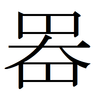器
| ||||||||
| ||||||||
Translingual
| Stroke order | |||
|---|---|---|---|
 | |||
| Japanese | 器 |
|---|---|
| Simplified | 器 |
| Traditional | 器 |
Alternative forms
- In all regions except Japan, the middle component is written 犬, which is the orthodox form found in the Kangxi dictionary.
- In Japanese shinjitai, the middle component is written 大 instead of 犬 (the upper right dot is missing). Due to Han unification, both forms are encoded using the same code point. This character may appear to be different depending on the font used.
- A CJK compatibility ideograph exists at
U+FA38for the kyūjitai form of 器 which has 犬 as the middle component. - Another character, 𠾖 (
U+20F96) exists for the historical form found in the Ming dynasty 《直音篇》 Chinese dictionary which is similar to Japanese shinjitai.
Han character
器 (radical 30, 口+13 in Chinese and Korean, 口+12 in Japanese, 16 strokes in Chinese and Korean, 15 strokes in Japanese, cangjie input 口口戈大口 (RRIKR), four-corner 66663, composition ⿱哭吅(GHTKV) or ⿳吅大吅(J))
Derived characters
- 𮣦, 𢻪, 𣀬, 𥀴, 𤼅, 𥷇, 𩆮, 𬑀
References
- KangXi: page 210, character 2
- Dai Kanwa Jiten: character 4349
- Dae Jaweon: page 432, character 26
- Hanyu Da Zidian: volume 1, page 690, character 7
- Unihan data for U+5668
Chinese
| simp. and trad. |
器 | |
|---|---|---|
| variant forms | ||
Glyph origin
| Historical forms of the character 器 | ||
|---|---|---|
| Western Zhou | Shuowen Jiezi (compiled in Han) | Liushutong (compiled in Ming) |
| Bronze inscriptions | Small seal script | Transcribed ancient scripts |
 |
 |
 |
Uncertain.
Possibly an ideogrammic compound (會意) : a 犬 (“dog”) guarding four 口 (“vessel”) – containers, or a phonetically borrowed character for the modern meanings with the original meaning being “to bark” (Compare 狺).
Pronunciation
Definitions
器
Compounds
|
|
|
Descendants
- → Korean: 그릇 (geureut, “receptacle; bowl; capacity; tolerance”) (Pan, 2006)
References
- Dictionary of Chinese Character Variants (教育部異體字字典), A00696
- “器”, in 漢語多功能字庫 (Multi-function Chinese Character Database), 香港中文大學 (the Chinese University of Hong Kong), 2014–
Japanese
| 器 | |

Etymology 1
| Kanji in this term |
|---|
| 器 |
| き Grade: 4 |
| on’yomi |
From Middle Chinese 器 (khijH, “vessel; instrument”).
Pronunciation
- On’yomi
- IPA(key): [kʲi]
- When used as a suffix, the resulting term has a downstep either right before, or one mora before, the ki.
- If the preceding syllable has only one mora (as in ga or tsu), the downstep occurs just after that mora:
- 瓦器 (“unglazed earthenware”): がき [gáꜜkì]
- 空気予熱器 (kūki yonetsuki, “air pre-heater”): くうきよねつき [kùúkí yónétsúꜜkì]
- If the preceding syllable has two morae (as in zen or tei), the downstep occurs between the two morae:
- 安全器 (anzenki, “safety cut-out”): あんぜんき [àńzéꜜǹkì]
- 円弧測定器 (enko sokuteiki, “cyclometer”): えんこそくていき [èńkó sókútéꜜèkì]
Usage notes
Often used interchangeably with 機 (ki) in compounds to indicate “machine”, with the subtlety that 器 implies a smaller device, perhaps hand-held, while 機 implies a larger machine, such as an airplane. Compare 食器 (shokki, “tableware”) and 飛行機 (hikōki, “airplane”), or homophones 機械 (kikai, “machine”, generally larger) and 器械 (kikai, “machine, tool”, generally smaller).
Derived terms
Usage notes
Can attach to various nouns that can be used as verbs, to indicate a device for carrying out the action. Examples:
- 計量 (keiryō, “measurement, measuring, gauging”) + 器 (-ki) = 計量器 (keiryōki, “a measuring device, a gauge”)
- 尿 (nyō, “urine”) + 器 (-ki) = 尿器 (nyōki, “urinal”)
- 印字 (inji, “print, type”, literally “stamp + character”) + 器 (-ki) = 印字器 (injiki, “a printer”, a smaller device, such as a handheld number and letter puncher)
Derived terms
Etymology 2
| Kanji in this term |
|---|
| 器 |
| うつわ Grade: 4 |
| kun’yomi |
/ut͡supa/ → /ut͡suɸa/ → /ut͡suwa/
From Old Japanese.[1] Cognate with 空 (utsuo, ancient utsupo, utsubo), signifying a hollowness. Appears to be a compound of 空, 内 (utsu, “hollow”, combining form, standalone form uchi, “inside”) + は (ha). The derivation of this ha element is unclear.
Noun
Derived terms
- 器物 (utsuwamono): a container; ability, talent; a musical instrument
Synonyms
References
- 1988, 国語大辞典(新装版) (Kokugo Dai Jiten, Revised Edition) (in Japanese), Tōkyō: Shogakukan
- 2006, 大辞林 (Daijirin), Third Edition (in Japanese), Tōkyō: Sanseidō, →ISBN
Korean
Hanja
器 • (gi) (hangeul 기, McCune–Reischauer ki)
- This term needs a translation to English. Please help out and add a translation, then remove the text
{{rfdef}}.
Vietnamese
Han character
器 (khí)
- This term needs a translation to English. Please help out and add a translation, then remove the text
{{rfdef}}.